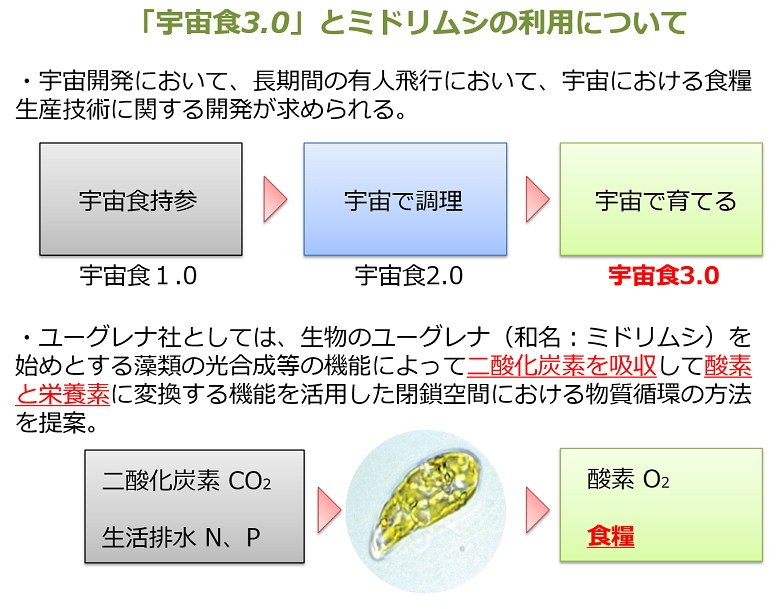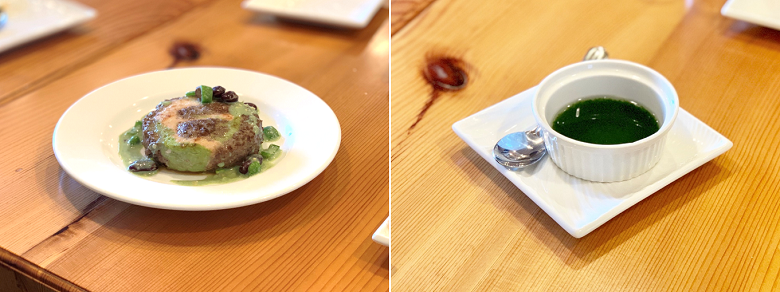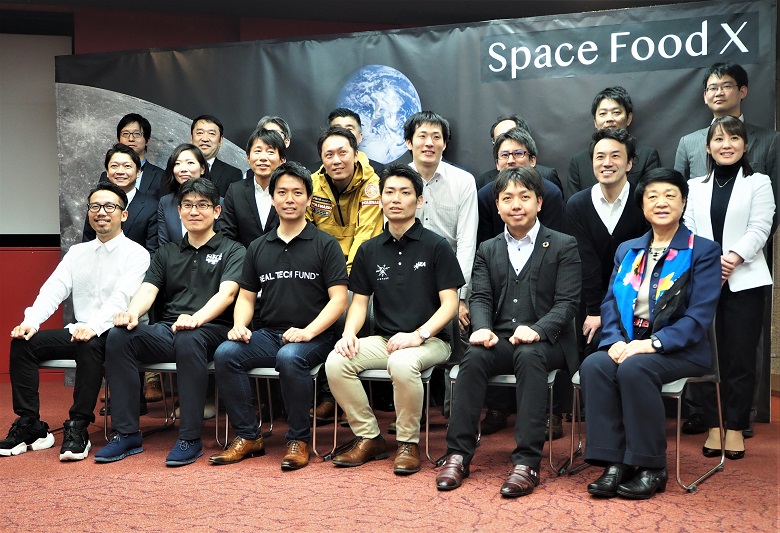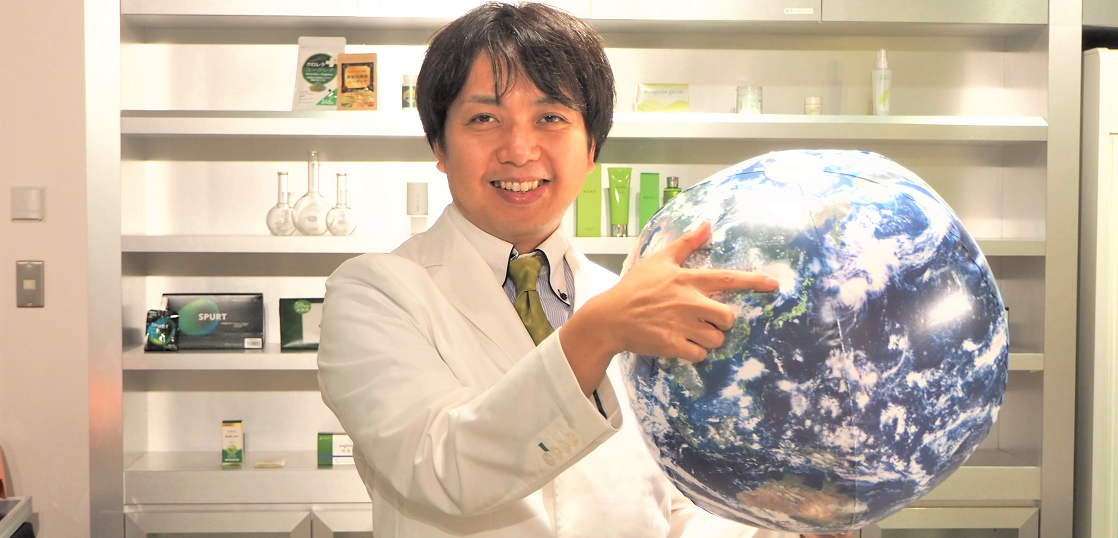今注目される宇宙開発。
その中でも宇宙食に関することにはさまざまな企業が参入し、活性化している分野です。
2040年には月面に1000人が住むとも言われ、「宇宙で人がどんな食事をとれるのか?」は気になるテーマです。
そんな宇宙での食事の未来について、農学博士/医学博士の鈴木がミドリムシを用いた宇宙食の可能性について語ります!
宇宙とミドリムシの関係は古い?
―ミドリムシと宇宙があまり結びつくイメージがないのですがいかがでしょうか?
鈴木:そうですか?ミドリムシを宇宙で培養することについては、実はこれまでに多く研究されています。1970年代からNASAでは、宇宙におけるミドリムシ培養の研究を行っていましたし、日本国内でも大阪府立大学名誉教授の中野長久先生が、宇宙空間を想定した環境でミドリムシの培養研究を行うなどしています。
―NASAも研究をしていたのですね。なぜ、みんなミドリムシを宇宙で培養することに興味を持つのでしょうか?
鈴木:理由は主に2つあります。
1つは、無重力で細胞分裂はどのように行われるのかという、生物学的な問いがあり、それを調査するのにミドリムシが適しているということがあげられます。
もうひとつは、人類が宇宙で生活するとなったときに、人間の食事を支えるプレイヤーとしても注目されているということがあげられます。
ミドリムシが宇宙食3.0を実現する
―人間の食事を支えるというと野菜やお肉をイメージしますが、なぜミドリムシなのですか?
鈴木:それは、ミドリムシは植物性と動物性の59種類の栄養素を持っているで、バランスの良い栄養素を一気に摂取できるのでということ、そして他の植物や動物と比べてスペース当たりの生産性が高いからです、生産性というのは、同じ面積で必要量×n人のn数が多いということですね。
また、宇宙では宇宙線と呼ばれる放射線が降り注いでいますがミドリムシは宇宙線に対する耐性がある※1のです。
※1:日本原子力研究所や放射線医学総合研究所の研究により、ユーグレナには放射線抵抗性があり、最も致死効果の高い放射線でも生育に影響がないことが分かっている。
―確かに、植物や動物を大きく育てようと思うと、多くの時間と水などの資源がたくさん必要となりますね。
鈴木:そうなんです。ミドリムシを含む藻類は、光と水と二酸化炭素と窒素やリンなどの栄養素により光合成をして育つのですが、茎や幹がないことから一般的な野菜などの植物と比べてスペース当たりの生産性の観点から優れています。それにミドリムシは環境が整えば1日で2倍になるという成長スピードの速さも特徴です。
光合成をして育つといいましたが、ということは二酸化炭素を吸収して酸素を生産するということで、人間が生きるのに必要な酸素の供給源にももちろんなります。
宇宙食3.0?
―ちなみに宇宙食というと、ゼリー飲料みたいな入れ物などにパッキングされたものをイメージしますが、ミドリムシも地球から持っていくのですか?
鈴木:いまJAXAは、宇宙食3.0という考え方を提唱しています。これは、宇宙で食物を生産し消費するという、宇宙における地産地消です。これまでの宇宙食は、質問のとおり地球から調理された食物をもっていく、いわゆる「宇宙食1.0」が中心でした。これからは、地球から食材を持っていき宇宙で調理する宇宙食2.0や、宇宙での地産地消を実現する宇宙食3.0が必要だということです。
なので、ミドリムシも最小限の株を宇宙に持っていって、宇宙で育てることを目指してます。

ミドリムシと人間を中心にした食物循環の実現
―宇宙でミドリムシの地産地消となると、ミドリムシだけ宇宙にもっていけばよいのですか?
鈴木:いえいえ、ミドリムシを育てるには水は必要になります。どこの星で育てるかにもよりますが、水がないのならば地球から持っていく必要がありますね。だいたい、人間1人分のミドリムシを作るには400ℓ、ドラム缶2本分程度の水が毎日必要です。
―月や火星には水があるかもしれないというニュースを見たことがあります。
鈴木:月や火星に水があればその水を活用できると思います。 2040年には月に1000人が住むともいわれていて、月の水と太陽光が利用できるとすれば、あとは人間が排出する二酸化炭素と排泄物を活用することで、ミドリムシを培養することができるかなと。
Space Food X!
―3月からJAXA×リアルテックファンドの「Space Food X」に参画していますが、何をしていくんでしょうか?
鈴木:まず、ミドリムシで宇宙食を楽しく健康なものにしたいなと。その想いも背景にしてなのですが、今までお話したようなミドリムシの生育をベースにした人間との循環環境づくりにくわえて、他の食材とのコラボレーションしながらミドリムシを使った宇宙食をより楽しくしていくことを検討していく予定です。
食事のエンターテインメントという観点からミドリムシ宇宙食のバリエーションを作っていきたいと考えています。

―おいしく楽しく宇宙でミドリムシ、楽しみです。
鈴木:はい、月への旅行とともに楽しみにしていただければと思います。

株式会社ユーグレナ 執行役員研究開発担当
鈴木 健吾(すずき けんご)
東京大学農学部生物システム工学専修卒、2005年8月株式会社ユーグレナ創業、取締役研究開発部長就任。同年12月に、世界でも初となる微細藻類ミドリムシ(学名:ユーグレナ)の食用屋外大量培養に成功。2016年東京大学大学院 農学博士学位取得。微細藻類ミドリムシの利活用およびその他藻類に関する研究に携わるかたわら、ミドリムシ由来のバイオ燃料製造開発に向けた研究に挑む。
東京都ベンチャー技術大賞受賞(2010年)、共著に『微細藻類の大量生産・事業化に向けた培養技術』(株式会社情報機構)。

